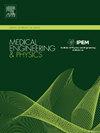Advance signal processing and machine learning approach for analysis and classification of knee osteoarthritis vibroarthrographic signals
IF 1.7
4区 医学
Q3 ENGINEERING, BIOMEDICAL
引用次数: 0
Abstract
Osteoarthritis is a common cause of disability among elderly significantly affecting their quality of life due to pain and functional limitations. This study proposes a novel, non-invasive, and cost-effective diagnostic technique using vibroarthrography (VAG) for early detection and grading of knee osteoarthritis (KOA) overcoming the limitations of traditional methods like X-rays, CT scans, and MRIs. Signal acquisition involved capturing of VAG signals from KOA patients using Thinklabs One digital stethoscope and a specialized knee brace within a frequency range of 20 Hz to 2000 Hz with a ± 3 dB tolerance at 44,000 samples per second. Various signal processing techniques, like time domain, statistical, PSD, wavelet, and Hilbert-Huang transform analysis, were used to study the resultant signal. Subsequently, a novel combination of self-organizing maps (SOMs) and K-means clustering was proposed to categorize VAG signals into distinct OA grade clusters. The resulting analysis identified distinct patterns in the time domain correlating with joint alteration severity. A SD/Mean ratio differentiated OA grades. Hilbert-Huang Transform established intrinsic mode functions relating frequency bands to OA stages, while wavelet and spectrogram analysis demonstrated increased signal complexity and variability with disease progression. The effectiveness of proposed clustering model was indicated by high mean Silhouette Coefficient (∼0.80) and low Davies-Bouldin Index (∼0.33) indicating distinct and accurate segmentation of OA stages. These findings clearly highlighted the potential of SOMs and K-means clustering in analysing VAG signals for classifying into different KOA grades. These results demonstrate the substantial potential of advanced signal processing, SOMs, and K-means clustering in uncovering complex patterns in VAG data, linking increasing knee sound signal complexity with OA progression. This highlights the potential of our approach in medical diagnostics, especially for chronic conditions like KOA, where early detection and ongoing monitoring are crucial.

先进的信号处理和机器学习方法分析和分类膝骨关节炎关节振动信号
骨关节炎是老年人残疾的常见原因,由于疼痛和功能限制,严重影响他们的生活质量。本研究提出了一种新的、无创的、具有成本效益的诊断技术,使用振动关节成像(VAG)来早期检测和分级膝骨关节炎(KOA),克服了传统方法(如x射线、CT扫描和核磁共振成像)的局限性。信号采集包括使用Thinklabs One数字听诊器和专用膝托在20 Hz至2000 Hz的频率范围内以每秒44,000个样本的±3db容差捕获KOA患者的VAG信号。各种信号处理技术,如时域、统计、PSD、小波和Hilbert-Huang变换分析,被用来研究得到的信号。随后,提出了一种自组织映射(SOMs)和K-means聚类的新组合,将VAG信号分类为不同的OA级聚类。结果分析确定了与关节变化严重程度相关的时域中不同的模式。SD/Mean比值区分OA等级。Hilbert-Huang变换建立了与OA分期相关频带的固有模态函数,而小波和谱图分析表明,随着疾病进展,信号的复杂性和变异性增加。高平均廓形系数(~ 0.80)和低戴维斯-博尔丁指数(~ 0.33)表明了所提出的聚类模型的有效性,这表明OA阶段的分割清晰而准确。这些发现清楚地强调了SOMs和K-means聚类在分析VAG信号以分类不同KOA等级方面的潜力。这些结果表明,先进的信号处理、SOMs和K-means聚类在揭示VAG数据的复杂模式方面具有巨大潜力,并将膝关节声音信号复杂性的增加与OA进展联系起来。这突出了我们的方法在医疗诊断方面的潜力,特别是对于像KOA这样的慢性疾病,早期发现和持续监测至关重要。
本文章由计算机程序翻译,如有差异,请以英文原文为准。
求助全文
约1分钟内获得全文
求助全文
来源期刊

Medical Engineering & Physics
工程技术-工程:生物医学
CiteScore
4.30
自引率
4.50%
发文量
172
审稿时长
3.0 months
期刊介绍:
Medical Engineering & Physics provides a forum for the publication of the latest developments in biomedical engineering, and reflects the essential multidisciplinary nature of the subject. The journal publishes in-depth critical reviews, scientific papers and technical notes. Our focus encompasses the application of the basic principles of physics and engineering to the development of medical devices and technology, with the ultimate aim of producing improvements in the quality of health care.Topics covered include biomechanics, biomaterials, mechanobiology, rehabilitation engineering, biomedical signal processing and medical device development. Medical Engineering & Physics aims to keep both engineers and clinicians abreast of the latest applications of technology to health care.
 求助内容:
求助内容: 应助结果提醒方式:
应助结果提醒方式:


